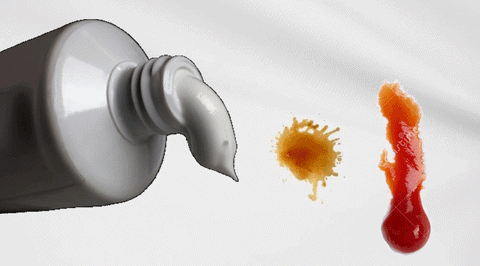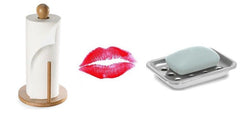Saree cleaning
Here we've put together important things to know to take good care of your handloom sarees:
- Basics of saree cleaning
- How to remove food stains from your white sarees?
- How to restore the lost shine in silk sarees?
- How to soften the stiffness in starched sarees?
- How to remove lipstick stains from your sarees?
Basics of Saree Cleaning
Once an exquisite piece of seven yards is bought it requires intelligent care for it runs the risk of getting ruined through improper storage or wash. Here are some keys points you should note when cleaning your sarees.
Cotton Sarees:
- Before washing a cotton saree for the first time, soak it for 10-15 minutes in a bucket of warm water mixed with rock salt. This will ensure that the colour latches on to the saree and will prevent the saree from ‘bleeding’ colour during subsequent washes.
- Use only a mild detergent to wash a cotton saree. Do not wring it vigorously; instead, hang it over a water-tap and allow the excess water to drain off.
- As a thumb rule, always starch cotton sarees (after wash) to ensure that they retain their crispness and stay stain-free.
- Hang the saree to dry in a shaded area only as allowing the sun’s rays to directly hit the saree will cause the colour to fade.
- Store the saree is an airy cupboard that is devoid of humidity and direct sunlight.
Silk Sarees:
- Never hand-wash or machine-wash a silk saree.
- In case the saree gets stained, immediately wipe the stain off with cold water.
- It is advisable to only dry-clean silk sarees.
- Never hang a silk saree to dry in direct sunlight as doing so will cause the colour to fade.
- Don’t keep the saree bundled up as this will result in the threads of the embroidery work getting entangled.
- Store the saree in a light cotton muslin cloth. This will give the saree breathing space and will prevent one saree from sticking to another when kept in a pile.
- Don’t store the saree in a plastic cover as this will cause the gold embroidery to turn black.
How to remove food stains from your white sarees?
There is nothing more refreshing than draping a pristine white tant, jamdani or garad saree to a ceremony or function. Yet during a careless moment, a drop of curry from your plate onto the plush fabric might ruin all your joy. Some food stains are too stubborn to soaps and detergents, which have little or no effect on them. Here's a handy tip on how to deal with such stains.

Wet the stain areas with water and apply a thick coat of white toothpaste over the stains on both sides of the fabric. Hang the saree to dry for 3-4 days. Now wash off the toothpaste. If the stain is completely gone, then good. If the stain is lighter, but still visible, repeat the process until the stain vanishes. Most oil, turmeric and other food stains can be completely removed from white clothes in this manner, without causing any discoloration to the fabric. Use a toothpaste containing bleach for better effect.
How to restore the lost shine in silk sarees?
Whether you wash your silk sarees at home or send them to the dry-cleaners, there is often a chance that the saree may lose its shine during the wash. You can follow these simple steps to restore some of the lost lustre in your silk sarees.
Make a dilute solution of distilled white vinegar and lukewarm water in a clean bucket (Use 1 tablespoon of vinegar for every litre of water). Soak the saree thoroughly in the vinegar solution for 3-5 minutes. Remove the saree from the solution and rinse it thoroughly in cold, running water. Make sure that all of the vinegar and its smell are washed off. Squeeze the saree gently without twisting or wringing.
Now dry the saree by wrapping it in a large, fluffy towel. You may need to fold the saree to fit it along the length of the towel. Gently roll and press the towel to remove excess water from the saree. Remove the saree from the towel and hang it to dry completely. Do not hang it in direct sunlight, as it may cause some discoloration. Silk sarees dry very quickly, and once dry, the lost sheen of the saree is restored.
If the saree needs ironing, then don’t wait for it to dry fully. When still damp, iron it on the inside or using the ‘silk’ setting on the iron. It is always advisable to spot test a small, hidden area of the saree before ironing it completely.
Caution: Never use a machine dryer to dry a silk saree. The dry, intense heat from the dryer can ruin the silk irreversibly.
How to soften the stiffness in starched sarees?
It is always a pleasure to drape crisp cotton sarees, when properly starched and ironed, to meetings and formal events. However, the stiffness in starched sarees can make them rather unmanageable too. This is often the case with brand new cotton sarees or some very fine silks such as garad or tussar. Here are some simple ways in which you can reduce the stiffness in your starched sarees.
1. If you want to soften the saree without removing the starch completely, then steam iron the saree. Remember to use the correct setting in your iron based on the saree fabric.
2. If you want to remove the starch completely, then soak the saree in cold water for 30 minutes. Then rinse, dry and steam iron the saree to remove all traces of starch.
3. For heavily starched sarees, add half a cup of distilled white vinegar to a bucket of cold water and soak the saree in it for 30 minutes. Then rinse, dry and steam iron the saree. It is now soft and starch-free!
How to remove lipstick stains from your sarees?
All sarees, and especially the white ones, run the risk of getting your lipstick accidentally smudged onto it, when you are putting on your makeup in a hurry! Don't worry! Even the darkest of lip colour stains can be removed if you can take action quickly.

- Place the stain area of the saree on a white tissue paper, with the stain side down.
- Dab the stain with a mild soap, using a clean white cloth. Let the soap sit on the stain for 10 minutes.
- Press the stain area with a clean white cloth. The lipstick and soap will seep into the paper towel underneath. Now replace the paper towel quickly. If not, the lipstick will spread on it, and may stain the saree back. Repeat this as long as the lipstick seeps into the paper towel.
- Rinse and wash the saree as you would normally do, in cold water.
- If some stain remains, repeat steps 2-4.
- Dry the saree only after the stain is fully gone.
